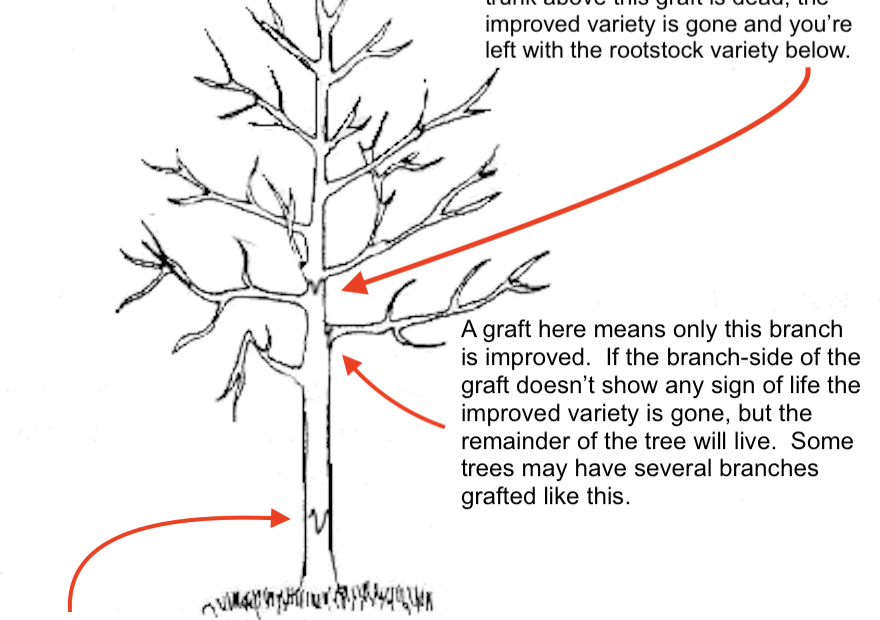
In the timeless symphony of nature’s grand orchestration, few quiet performers captivate the human imagination quite like the elegant fig tree. With its lush foliage, whimsical branches, and succulent fruits adorning the landscape, these arboreal wonders have sparked wonder and curiosity since ancient times. However, amidst the ebb and flow of life’s delicate dance, even the mightiest and most resilient fig trees can eventually succumb to the inevitable embrace of mortality. Yet, fear not, for in this guide, we shall delve into the depths of their enchanting existence and unravel the subtle signs, the silent whispers, that reveal the true fate of the fig tree. Gather your senses, fellow nature enthusiasts, as we embark on a quest to uncover the secrets that lay hidden within and learn how to discern whether a fig tree has gracefully retired to the realm of dreams or if it still flourishes against the odds, waiting to grace the world with its splendor.

Recognizing the Signs of a Dying Fig Tree
When it comes to fig trees, it’s important to keep a watchful eye for signs of decline. Fig trees are incredibly resilient and can thrive for many years, but they can also succumb to various issues that can ultimately lead to their demise. By , you can take action to potentially save it or prevent further damage.
Here are some key indicators that your fig tree may be on its last leg:
| Yellowing leaves: |
Leaves that turn yellow and start to drop off can be a clear sign of a struggling fig tree. |
| Limited growth: |
If your fig tree has stopped producing new shoots and branches, it may be in a state of decline. |
| Brittle branches: |
When branches become dry and brittle, it’s a sign that they are no longer receiving the necessary nutrients and moisture. |
Remember, these signs alone may not necessarily mean that your fig tree is beyond saving, but they should prompt you to take action. By addressing the underlying issues and providing proper care, you may be able to revive your fig tree and bring it back to a healthy state.

Loading... Seconds Left for
Miniature Orchid Terrarium Gallery!

Analyzing Leaf and Stem Conditions to Assess Fig Tree Health
When it comes to determining the health of a fig tree, analyzing the condition of its leaves and stems can be very revealing. By carefully observing these aspects, you can gain valuable insight into whether your fig tree is thriving or if it has unfortunately met its end. Here are some key features and tips to help you assess the life pulsating through those branches.
<
h2>
Leaf Indicators:
- Color: One of the first things to scrutinize is the color of the leaves. **Bright green** signifies vitality, while yellowing or browning leaves could signal impending doom.
- Texture: Healthy fig leaves should have a **smooth and lustrous** texture. If they appear dull, wrinkled, or have patches of fuzz, it might be cause for concern.
- Absence of Leaves: A fig tree without leaves can often be a strong indication of major underlying issues. This absence may be due to prolonged exposure to extreme temperatures, lack of water, or even pest infestations.
<
div>
Stem Conditions:
- Flexibility: Gently bending a fig tree’s stems can reveal their flexibility. If they snap easily or feel brittle, it suggests a lack of moisture or nutrient deficiency.
- Texture: Healthy stems typically have a **smooth and firm** texture, indicating their ability to transport essential fluids throughout the tree. Conversely, rough or cracked texture might indicate compromised vascular systems.
- Growth Signs: Observe for new sprouts, buds, or fresh branches. The presence of these signs suggests that the fig tree is still striving to grow, even if it appears fragile at the moment.
Features & Tips:
| Features |
|
Tips |
| Leaf Color |
• |
Check for brightness or discoloration |
| Leaf Texture |
• |
Examine for smoothness and luster |
| Absence of Leaves |
• |
Investigate underlying causes |
| Flexibility of Stems |
• |
Assess resilience and brittleness |
| Stem Texture |
• |
Observe for smoothness or cracks |
| Growth Signs |
• |
Look out for new sprouts and buds |

Checking Soil Moisture and Drainage for Fig Tree Revival
When it comes to reviving a fig tree, assessing the soil moisture and drainage is of utmost importance. Fig trees are known for their sensitivity to water levels, so understanding the moisture content in the soil and ensuring proper drainage can make all the difference in bringing your tree back to life. Here are some helpful tips and features to consider:
| Features |
Tips |
| 1. Soil Moisture Meter: |
Invest in a reliable moisture meter to accurately measure the moisture levels in the soil. This will help you determine if the tree is receiving adequate water or if it’s being over-watered. |
| 2. Mulching: |
Apply a layer of organic mulch around the base of the tree to retain moisture in the soil. This will also help regulate the temperature and prevent weed growth. |
| 3. Improving Drainage: |
If the soil is poorly drained, consider creating a raised bed or adding organic matter such as compost to improve drainage. This will prevent waterlogging and root rot, which could be detrimental to your fig tree’s health. |
By regularly monitoring soil moisture and ensuring proper drainage, you can provide a favorable environment for your fig tree to thrive. Remember to water your tree consistently, while avoiding overwatering, as excessive moisture can lead to root issues. With the right care and attention, you can revive your fig tree and enjoy its delicious fruits for years to come.
![]()
ng="async" class="kimage_class" src="https://up-gardening.com/wp-content/uploads/2023/10/photo-1666153658047-de52bbb14002.jpg652cd666e4cf9.jpg" alt="Expert Tips for Saving a Dying Fig Tree">
Expert Tips for Saving a Dying Fig Tree
If you’re worried that your beloved fig tree is on its last legs, here are some expert tips to help you determine if your fig tree is truly dead or if there’s still hope for revival.
1. Inspect the branches: Check for any signs of life by scratching the bark gently. If you notice green tissue beneath the outer layer, your fig tree may still have a chance. However, if the branches are dry and brittle, it could be a sign of death.
2. Assess t
he trunk: Examine the trunk for any signs of decay or fungal growth. Healthy fig tree trunks should be firm and free from any soft spots or moldy patches.
| Features |
Tips |
| Leaf condition |
If the leaves are crispy and brown, it might be a sign that your fig tree is beyond saving. |
| Root health |
Gently dig around the base of the tree to inspect the roots. Healthy roots are firm and white, while rotted or mushy roots indicate a dying tree. |
| Regrowth potential |
If new shoots or buds are appearing from the branches, it’s a positive sign that your fig tree can still recover. |
Remember, even if your fig tree appears lifeless, it’s worth considering professional help or experimenting with some revival techniques before giving up. Sometimes, with a little care and patience, fig trees surprise us with their resilience!
Frequently Asked Questions
Q: Is my fig tree merely “playing dead” or is it actually deceased?
A: Much like a talented actor, a “dead” fig tree can sometimes fool us with its convincing act, but there are telltale signs to discern if it’s truly departed from this mortal coil.
Q: Can a fi
g tree miraculously resurrect from the brink of death?
A: While divine resurrection may be reserved for biblical tales, fig trees possess astonishing resilience. With the right care and a dash of optimism, you might witness a Lazarus-like revival in your beloved plant.
Q: What are the unmistakable signs that a fig tree has passed on to the great orchard in the sky?
A: When a fig tree bids adieu, it reveals its departure through withered leaves, brittle branches, and a barrenness that even Mother Nature cannot easily hide. Keep an eye out for these indisputable signals of the tree’s passing. As we bid adieu to the fascinating realm of fig trees, we can now confidently distinguish between the vibrant breathing souls and the solemn silence of the botanical world. Remember, dear readers, that the embers of knowledge we have kindled together today shall guide you on your horticultural quests, banishing the veil of uncertainty that shadows the fate of your beloved fig trees.
In this voyage, our minds have come alive with the pivotal milestones that herald the existence of life or demise in the world of fig trees. From the subtle whispers of shriveled leaves to the stark crumbles of brittle branches, we have unraveled the secrets that lay dormant within their skeletal frameworks. Armed with this newfound wisdom, you will approach your verdant companions with a discerning eye, adept at deciphering their silent cries for help.
As our fora
y into the realm of fig trees draws to a close, we entreat you to remember that death is but a natural part of life’s ceaseless cycle. Witnessing the withering of a fig tree can be a somber experience, yet we must embrace the ebb and flow of existence, cherishing the lessons it imparts upon us. The absence of vitality does not diminish the profound beauty and wisdom that these majestic trees have shared with us throughout the ages.
Let us not mourn the departed, but instead celebrate the resilient gardeners that dwell within us all. For even amidst the sorrow of loss, we are granted the opportunity to plant the seeds of growth and nurture the saplings that persevere amidst the struggles of life. Be it in the shade of a lively fig tree or beneath the weight of a departed soul, let us remember that it is our duty to coax life from death’s embrace.
So, dear seekers of truth and guardians of green, fear not the uncertainty that accompanies the question “Is my fig tree dead?” Armed with the knowledge you have acquired today, you possess the power to unravel the enigma of life and to pay homage to the ancient wisdom bestowed upon us by these remarkable arboreal companions.
As we part
ways, we implore you to nurture not just your gardens but also the insatiable curiosity that has led you to this moment. In the tapestry of life, the eternal dance between birth and decay, we find solace and inspiration, forever grateful for the fig trees that have graced our landscapes, both past and present. May your journeys be graced with verdant abundance, and may you find solace in the evergreen legacy of these enchanting trees.
="abh_tab_content">
Hello! I'm Jessica Owen, an avid gardener and proud contributor to Up-Gardening.com. Gardening is my passion, and I'm delighted to share my green-thumb experiences with you. From planting tips to nurturing blooms, I'm here to help you cultivate your own slice of paradise. Let's grow together in the garden!
Latest posts by Jessica Owen
(see all)v>
<
!-- CONTENT END 1 -->





